publications
publications by categories in reversed chronological order. generated by jekyll-scholar.
2025
Journal Articles
-
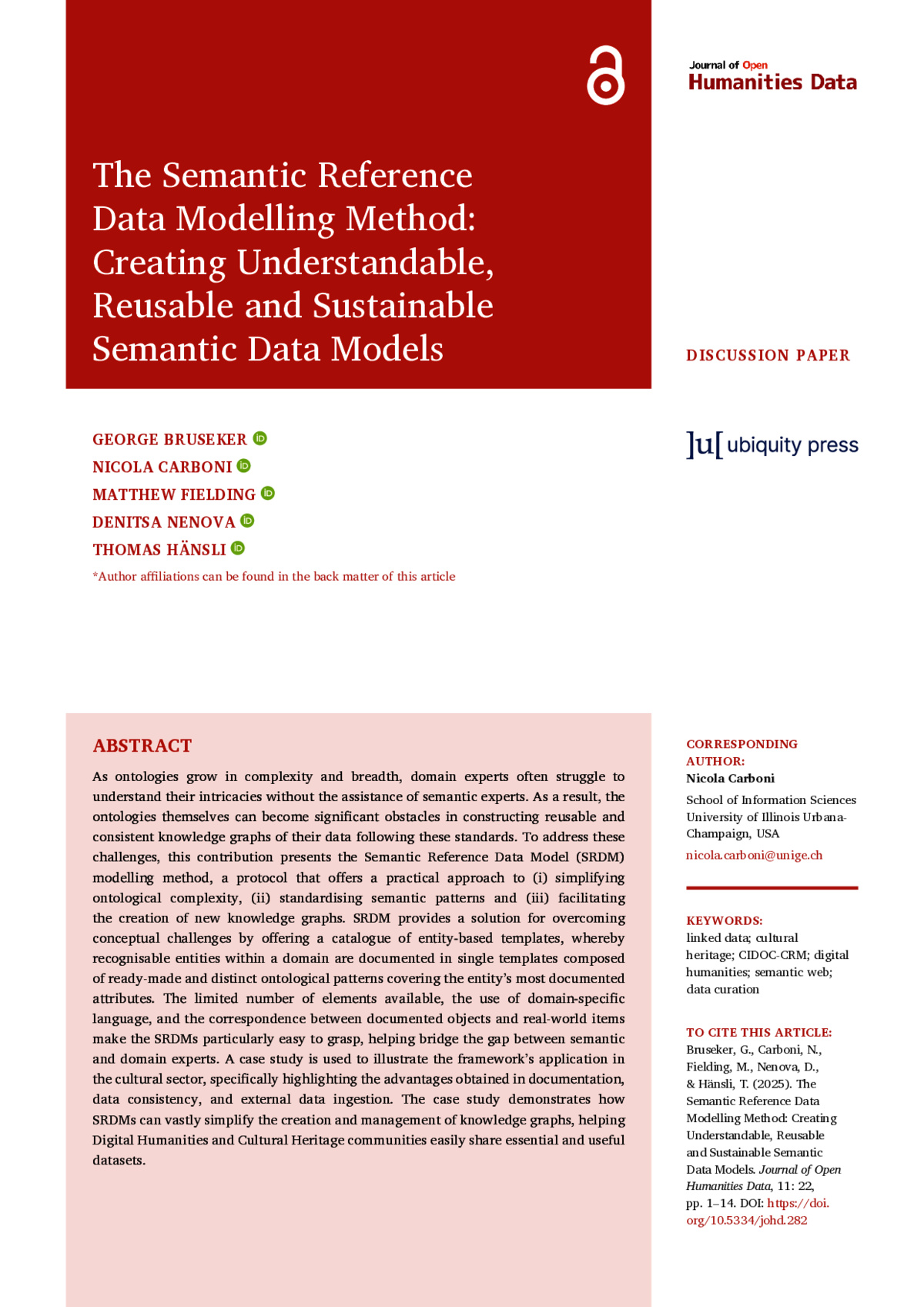 The Semantic Reference Data Modelling Method: Creating Understandable, Reusable and Sustainable Semantic Data ModelsGeorge Bruseker, Nicola Carboni, Matthew Fielding, and 2 more authorsJournal of Open Humanities Data, 2025
The Semantic Reference Data Modelling Method: Creating Understandable, Reusable and Sustainable Semantic Data ModelsGeorge Bruseker, Nicola Carboni, Matthew Fielding, and 2 more authorsJournal of Open Humanities Data, 2025As ontologies grow in complexity and breadth, domain experts often struggle to understand their intricacies without the assistance of semantic experts. As a result, the ontologies themselves can become significant obstacles in constructing reusable and consistent knowledge graphs of their data following these standards. To address these challenges, this contribution presents the Semantic Reference Data Model (SRDM) modelling method, a protocol that offers a practical approach to (i) simplifying ontological complexity, (ii) standardising semantic patterns and (iii) facilitating the creation of new knowledge graphs. SRDM provides a solution for overcoming conceptual challenges by offering a catalogue of entity-based templates, whereby recognisable entities within a domain are documented in single templates composed of ready-made and distinct ontological patterns covering the entity’s most documented attributes. The limited number of elements available, the use of domain-specific language, and the correspondence between documented objects and real-world items make the SRDMs particularly easy to grasp, helping bridge the gap between semantic and domain experts. A case study is used to illustrate the framework’s application in the cultural sector, specifically highlighting the advantages obtained in documentation, data consistency, and external data ingestion. The case study demonstrates how SRDMs can vastly simplify the creation and management of knowledge graphs, helping Digital Humanities and Cultural Heritage communities easily share essential and useful datasets.
@article{brusekerSemanticReferenceData2025, title = {The {{Semantic Reference Data Modelling Method}}: {{Creating Understandable}}, {{Reusable}} and {{Sustainable Semantic Data Models}}}, shorttitle = {The {{Semantic Reference Data Modelling Method}}}, author = {Bruseker, George and Carboni, Nicola and Fielding, Matthew and Nenova, Denitsa and H{\"a}nsli, Thomas}, year = {2025}, journal = {Journal of Open Humanities Data}, volume = {11}, number = {1}, issn = {2059-481X}, doi = {10.5334/johd.282}, langid = {english}, }
Book Chapters
-
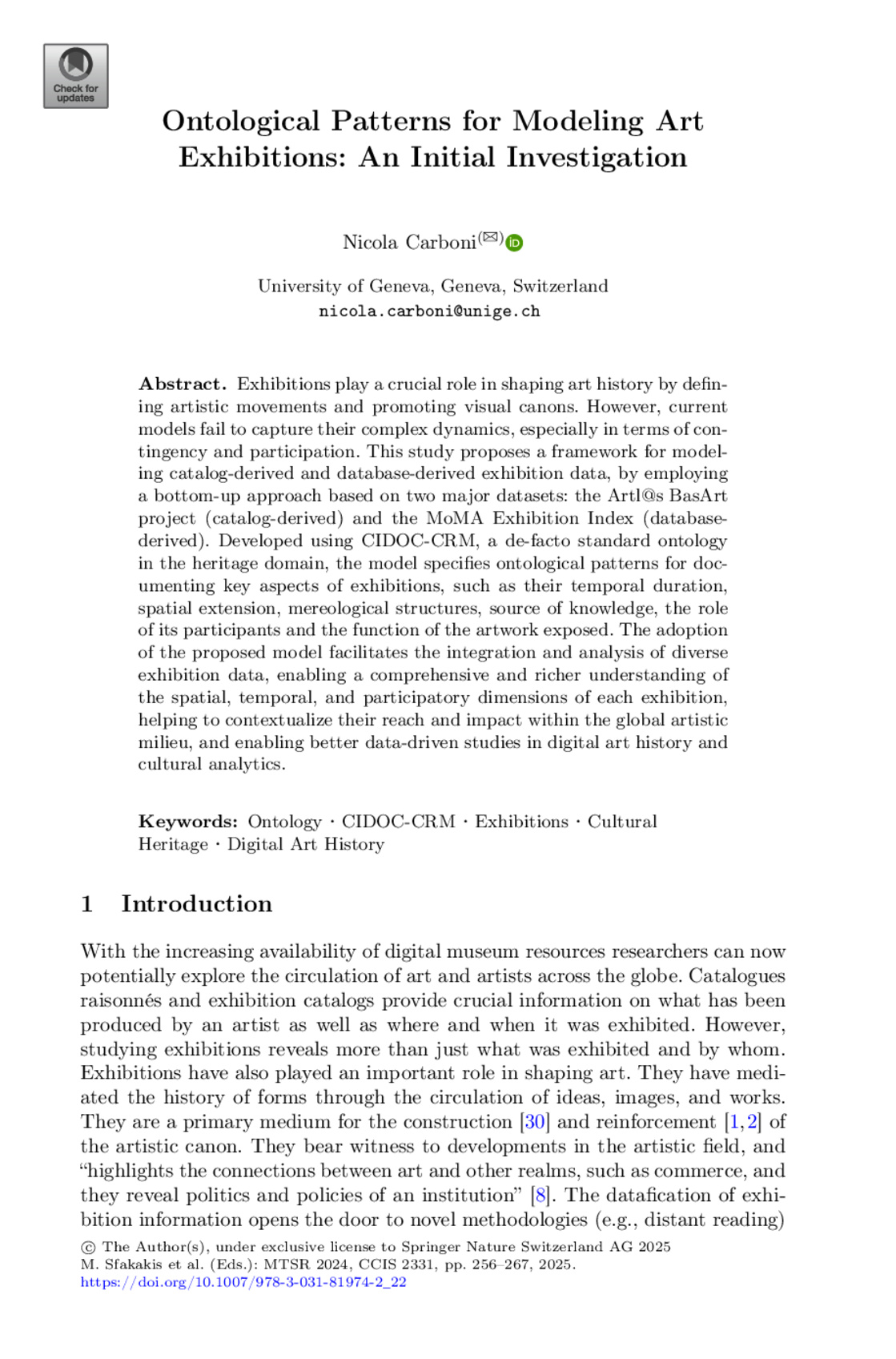 Ontological Patterns for Modeling Art Exhibitions: An Initial InvestigationNicola CarboniIn Metadata and Semantic Research, 2025
Ontological Patterns for Modeling Art Exhibitions: An Initial InvestigationNicola CarboniIn Metadata and Semantic Research, 2025Exhibitions play a crucial role in shaping art history by defining artistic movements and promoting visual canons. However, current models fail to capture their complex dynamics, especially in terms of contingency and participation. This study proposes a framework for modeling catalog-derived and database-derived exhibition data, by employing a bottom-up approach based on two major datasets: the Artl@s BasArt project (catalog-derived) and the MoMA Exhibition Index (database-derived). Developed using CIDOC-CRM, a de-facto standard ontology in the heritage domain, the model specifies ontological patterns for documenting key aspects of exhibitions, such as their temporal duration, spatial extension, mereological structures, source of knowledge, the role of its participants and the function of the artwork exposed. The adoption of the proposed model facilitates the integration and analysis of diverse exhibition data, enabling a comprehensive and richer understanding of the spatial, temporal, and participatory dimensions of each exhibition, helping to contextualize their reach and impact within the global artistic milieu, and enabling better data-driven studies in digital art history and cultural analytics.
@incollection{carboniOntologicalPatternsModeling2025, title = {Ontological {{Patterns}} for~{{Modeling Art Exhibitions}}: {{An~Initial Investigation}}}, booktitle = {Metadata and {{Semantic Research}}}, author = {Carboni, Nicola}, editor = {Sfakakis, Michalis and Garoufallou, Emmanouel and Damigos, Matthew and Salaba, Athena and Papatheodorou, Christos}, year = {2025}, pages = {256--267}, publisher = {Springer Nature Switzerland}, address = {Cham}, doi = {10.1007/978-3-031-81974-2_22}, isbn = {978-3-031-81974-2}, }
2024
Conference Articles
-
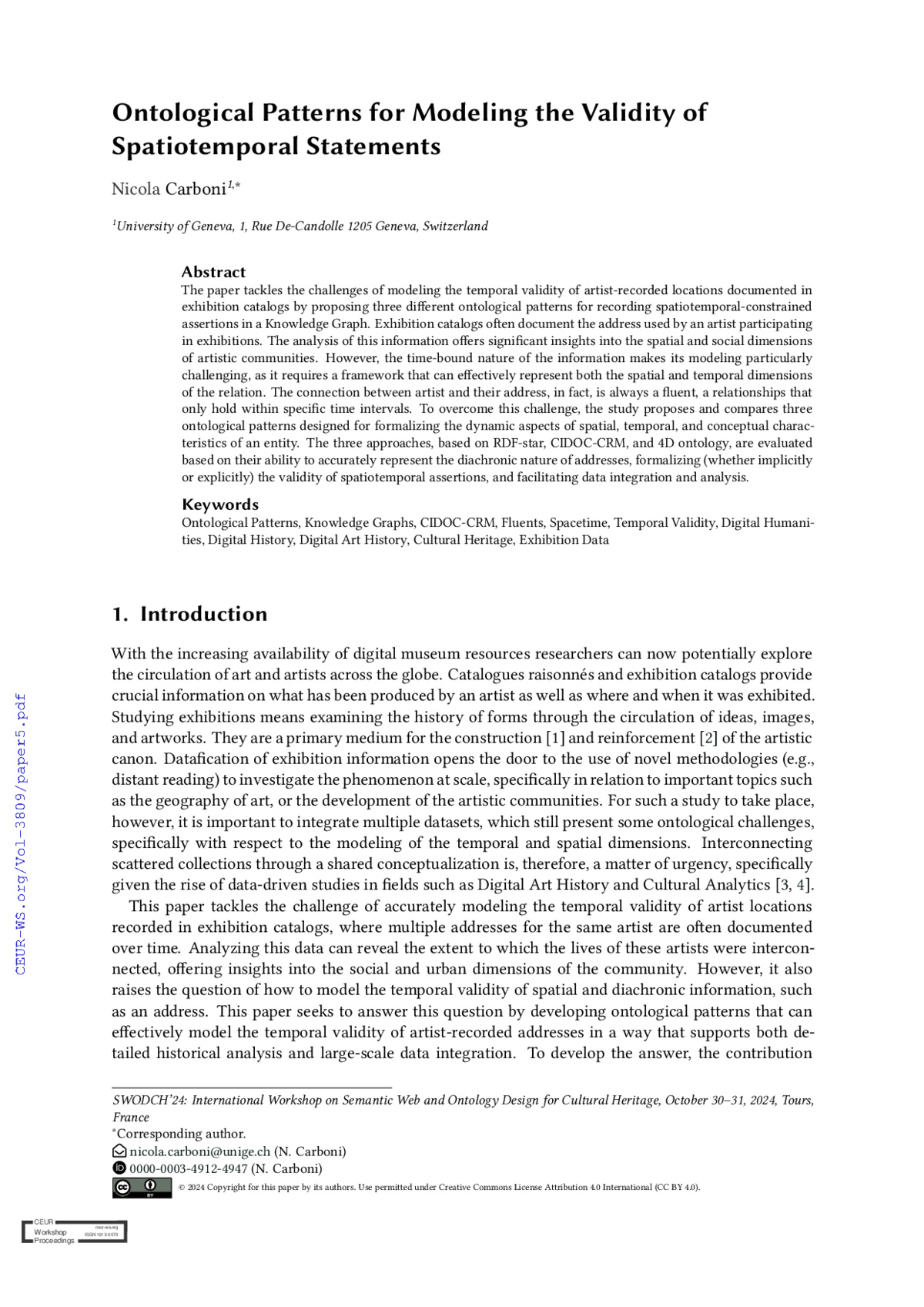 Ontological Patterns for Modeling the Validity of Spatiotemporal StatementsNicola CarboniIn Proceedings of the Fourth Edition of the International Workshop on Semantic Web and Ontology Design for Cultural Heritage, 2024
Ontological Patterns for Modeling the Validity of Spatiotemporal StatementsNicola CarboniIn Proceedings of the Fourth Edition of the International Workshop on Semantic Web and Ontology Design for Cultural Heritage, 2024The paper tackles the challenges of modeling the temporal validity of artist-recorded locations documented in exhibition catalogs by proposing three different ontological patterns for recording spatiotemporal-constrained assertions in a Knowledge Graph. Exhibition catalogs often document the address used by an artist participating in exhibitions. The analysis of this information offers significant insights into the spatial and social dimensions of artistic communities. However, the time-bound nature of the information makes its modeling particularly challenging, as it requires a framework that can effectively represent both the spatial and temporal dimensions of the relation. The connection between artist and their address, in fact, is always a fluent, a relationships that only hold within specific time intervals. To overcome this challenge, the study proposes and compares three ontological patterns designed for formalizing the dynamic aspects of spatial, temporal, and conceptual characteristics of an entity. The three approaches, based on RDF-star, CIDOC-CRM, and 4D ontology, are evaluated based on their ability to accurately represent the diachronic nature of addresses, formalizing (whether implicitly or explicitly) the validity of spatiotemporal assertions, and facilitating data integration and analysis.
@inproceedings{carboniOntologicalPatternsModeling2024, title = {Ontological {{Patterns}} for {{Modeling}} the {{Validity}} of {{Spatiotemporal Statements}}}, booktitle = {Proceedings of the Fourth Edition of the {{International Workshop}} on {{Semantic Web}} and {{Ontology Design}} for {{Cultural Heritage}}}, author = {Carboni, Nicola}, year = {2024}, volume = {Vol-3809}, publisher = {CEUR-WS}, address = {Tours}, langid = {english}, }
Journal Articles
-
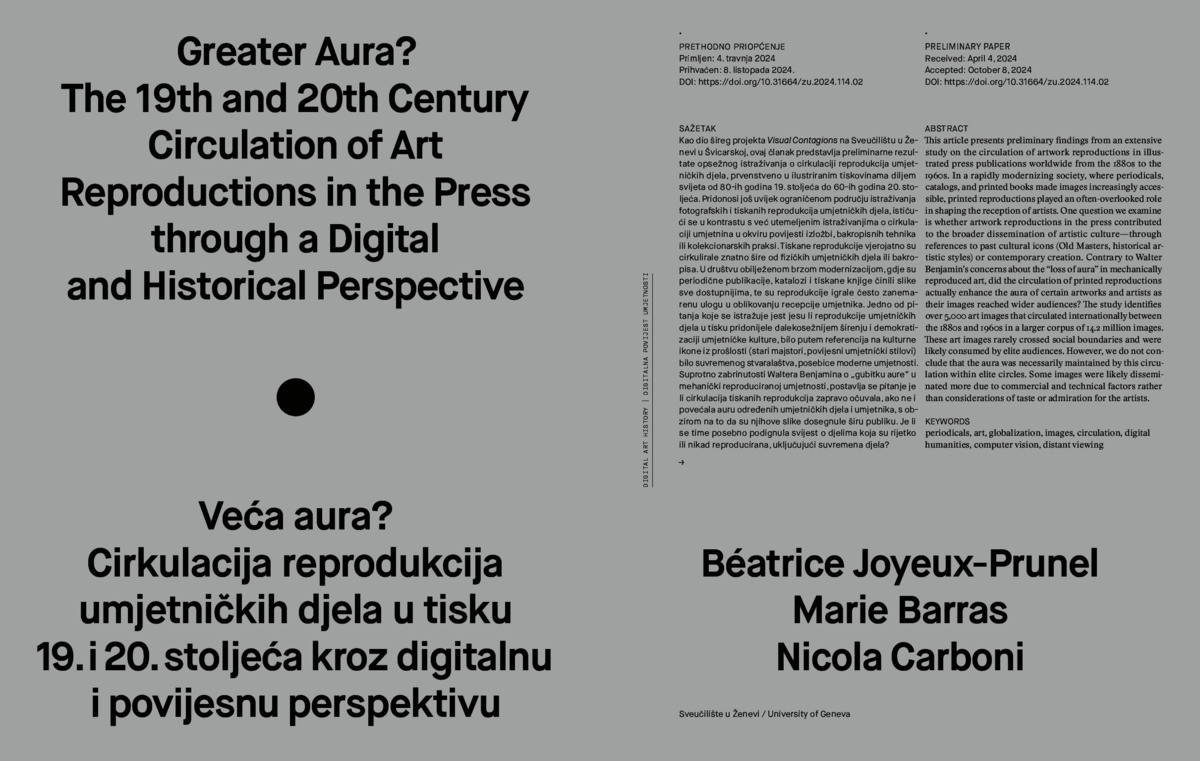 Greater Aura? The 19th and 20th Century Circulation of Art Reproductions in the Press through a Digital and Historical PerspectiveBéatrice Joyeux-Prunel, Marie Barras, and Nicola CarboniŽivot umjetnosti : časopis o modernoj i suvremenoj umjetnosti i arhitekturi, Jul 2024
Greater Aura? The 19th and 20th Century Circulation of Art Reproductions in the Press through a Digital and Historical PerspectiveBéatrice Joyeux-Prunel, Marie Barras, and Nicola CarboniŽivot umjetnosti : časopis o modernoj i suvremenoj umjetnosti i arhitekturi, Jul 2024This article presents preliminary findings from an extensive study on the circulation of artwork reproductions in illustrated press publications worldwide from the 1880s to the 1960s. In a rapidly modernizing society, where periodicals, catalogs, and printed books made images increasingly accessible, printed reproductions played an often-overlooked role in shaping the reception of artists. One question we examine is whether artwork reproductions in the press contributed to the broader dissemination of artistic culture—through references to past cultural icons (Old Masters, historical artistic styles) or contemporary creation. Contrary to Walter Benjamin’s concerns about the “loss of aura” in mechanically reproduced art, did the circulation of printed reproductions actually enhance the aura of certain artworks and artists as their images reached wider audiences? The study identifies over 5,000 art images that circulated internationally between the 1880s and 1960s in a larger corpus of 14.2 million images. These art images rarely crossed social boundaries and were likely consumed by elite audiences. However, we do not conclude that the aura was necessarily maintained by this circulation within elite circles. Some images were likely disseminated more due to commercial and technical factors rather than considerations of taste or admiration for the artists.
@article{joyeux-prunelGreaterAura19th2024, title = {Greater {{Aura}}? {{The}} 19th and 20th {{Century Circulation}} of {{Art Reproductions}} in the {{Press}} through a {{Digital}} and {{Historical Perspective}}}, shorttitle = {Greater {{Aura}}?}, author = {{Joyeux-Prunel}, B{\'e}atrice and Barras, Marie and Carboni, Nicola}, year = {2024}, month = jul, journal = {{\v Z}ivot umjetnosti : {\v c}asopis o modernoj i suvremenoj umjetnosti i arhitekturi}, volume = {114}, number = {1}, pages = {26--49}, publisher = {Institut za povijest umjetnosti}, issn = {0514-7794, 1849-2207}, doi = {10.31664/zu.2024.114.02}, urldate = {2025-03-31}, langid = {english}, } -
 Plotting the Geopolitics of Twentieth-Century Modern and Avant-Garde Illustrated PeriodicalsBéatrice Joyeux-Prunel, Nicola Carboni, and Marie BarrasJournal of European Periodical Studies, Jun 2024
Plotting the Geopolitics of Twentieth-Century Modern and Avant-Garde Illustrated PeriodicalsBéatrice Joyeux-Prunel, Nicola Carboni, and Marie BarrasJournal of European Periodical Studies, Jun 2024Illustrated journals are available digitally in unprecedented quantities, and on a global scale. As such, they provide the ideal foundation to examine globalization logics in the history of art and literature through the prism of ‘distant reading and viewing’. When articulated and completed by more traditional close reading of the sources, a computational approach can raise new questions about the international circulation of images in illustrated periodicals. It may help to reinterpret, and even better understand, the variety of flows and imbalances in the international circulation of images, that are often taken too quickly as evidence of centrality or peripherality. This paper presents the perspectives opened by the Visual Contagions project (SNSF, University of Geneva, CH), which analyses images from thousands of illustrated periodicals published worldwide from the 1890s to the 1990s. Images do not magically circulate, nor do styles ‘diffuse’ and provide evidence of ‘influences’, as it is often assumed. The computational approach is used to analyse avant-garde periodicals, and it allowed us to highlight networks of image exchange, affinities between magazines, countries, and cultural or social milieus. Such methodologies emphasize the social logics that promoted the circulation of images and styles, and unveil the authorial or distributive role of some key publications in the avant-garde; but they also reveal and help understand image diffusions that were previously difficult to explain other than by a Zeitgeist, by the notion of centres and peripheries, or by a formalist approach that consolidated the non-questioned domination of European canons.
@article{joyeux-prunelPlottingGeopoliticsTwentiethCentury2024, title = {Plotting the {{Geopolitics}} of {{Twentieth-Century Modern}} and {{Avant-Garde Illustrated Periodicals}}}, author = {{Joyeux-Prunel}, B{\'e}atrice and Carboni, Nicola and Barras, Marie}, year = {2024}, month = jun, journal = {Journal of European Periodical Studies}, volume = {9}, number = {1}, publisher = {Ghent University}, issn = {2506-6587}, doi = {10.21825/jeps.87043}, urldate = {2024-10-28}, langid = {english}, }
2023
Conference Articles
-
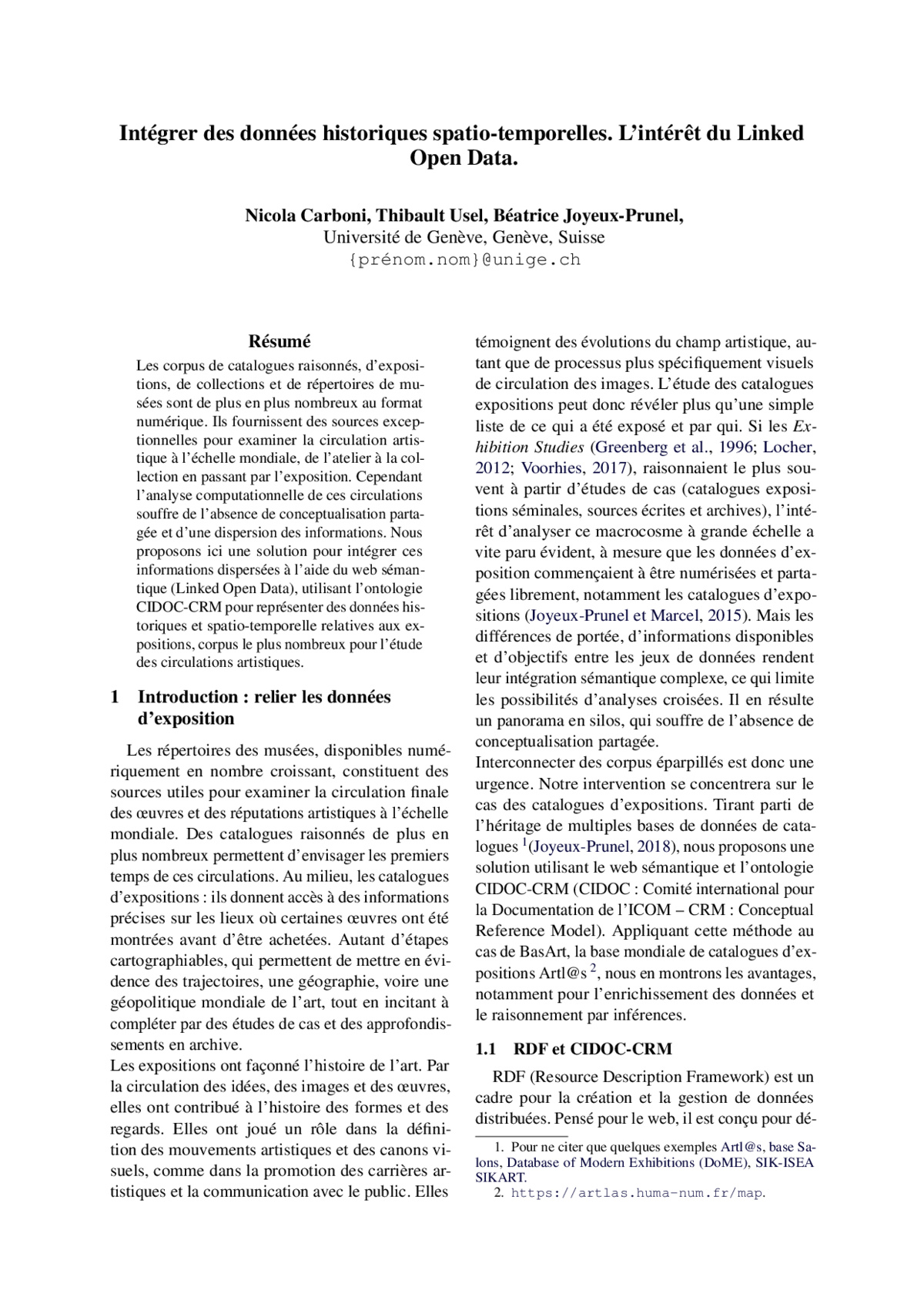 Intégrer Des Données Historiques Spatio-TemporellesNicola Carboni, Thibault Usel, and Beatrice Joyeux-PrunelIn Humanistica 2023, Jun 2023
Intégrer Des Données Historiques Spatio-TemporellesNicola Carboni, Thibault Usel, and Beatrice Joyeux-PrunelIn Humanistica 2023, Jun 2023Les corpus de catalogues raisonnés, d’expositions, de collections et de répertoires de musées sont de plus en plus nombreux au format numérique. Ils fournissent des sources exceptionnelles pour examiner la circulation artistique à l’échelle mondiale, de l’atelier à la collection en passant par l’exposition. Cependant l’analyse computationnelle de ces circulations souffre de l’absence de conceptualisation partagée et d’une dispersion des informations. Nous proposons ici une solution pour intégrer ces informations dispersées à l’aide du web sémantique (Linked Open Data), utilisant l’ontologie CIDOC-CRM pour représenter des données historiques et spatio-temporelle relatives aux expositions, corpus le plus nombreux pour l’étude des circulations artistiques.
@inproceedings{carboniIntegrerDonneesHistoriques2023, title = {Int{\'e}grer Des Donn{\'e}es Historiques Spatio-Temporelles}, booktitle = {Humanistica 2023}, volume = {Humanistica 2023}, author = {Carboni, Nicola and Usel, Thibault and {Joyeux-Prunel}, Beatrice}, year = {2023}, publisher = {Association francophone des humanit{\'e}s num{\'e}riques}, address = {Geneva}, } -
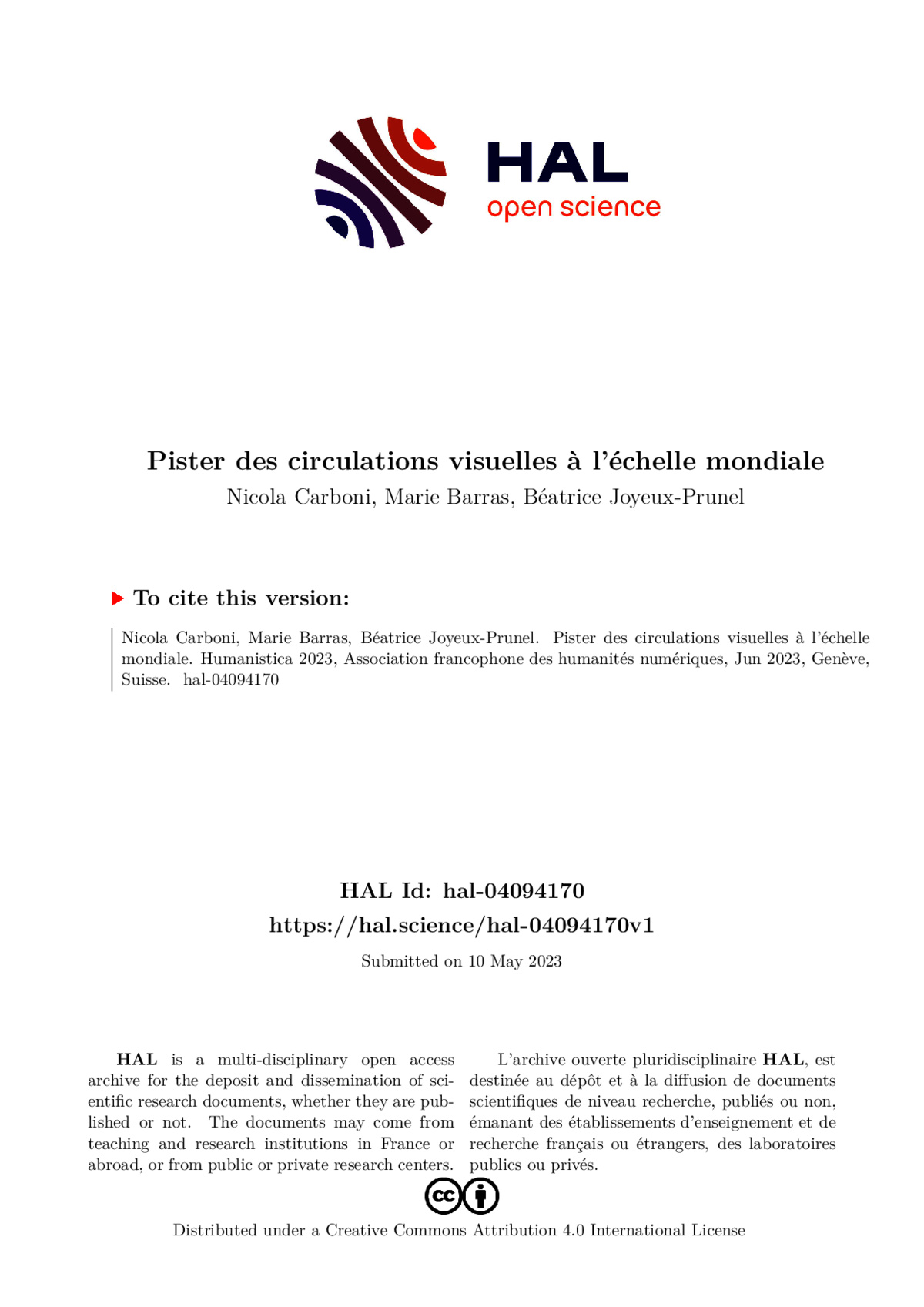 Pister Des Circulations Visuelles à l’échelle MondialeNicola Carboni, Marie Barras, and Béatrice Joyeux-PrunelIn Humanistica 2023, Jun 2023
Pister Des Circulations Visuelles à l’échelle MondialeNicola Carboni, Marie Barras, and Béatrice Joyeux-PrunelIn Humanistica 2023, Jun 2023De la fin du XIXe s. à la généralisation des images sur internet, la presse illustrée a été une force motrice déterminante pour la circulation des images. Elle a touché des publics élargis, diffusant par l’image des idées, des pratiques, des représentations. Mais s’il semble aisé d’étudier la rencontre et le métissage de quelques images, comment comprendre les circulations visuelles à grande échelle? Comment étudier la mondialisation par l’image sans se contenter d’études de cas ? Tel est le défi du projet Visual Contagions, mené par la chaire d’humanités numériques de l’université de Genève avec le soutien du Fonds national suisse.
@inproceedings{carboniPisterCirculationsVisuelles2023, title = {Pister Des Circulations Visuelles {\`a} l'{\'e}chelle Mondiale}, booktitle = {Humanistica 2023}, author = {Carboni, Nicola and Barras, Marie and {Joyeux-Prunel}, B{\'e}atrice}, year = {2023}, volume = {Humanistica 2023}, }
Journal Articles
-
 The Mediatization of the Early Automobile: A Visual Analysis of the Illustrated Press in the Late 19th and Early 20th CenturyNicola CarboniArtl@s Bulletin, Jun 2023
The Mediatization of the Early Automobile: A Visual Analysis of the Illustrated Press in the Late 19th and Early 20th CenturyNicola CarboniArtl@s Bulletin, Jun 2023The paper presents a digital analysis of automobile imagery in the early 20th-century press, examining the mediatization of the anti-car movement and the role images played in conveying and furthering the activist discourse. To investigate the phenomenon, the author compiled and analyzed over 5,000 images from in 185 journals published in 45 cities between 1891 and 1950. The analysis revealed a preponderance of positive representations of the automobile in the press, whilst evidence of negative sentiment towards the automobile, such as protests and accidents, was conspicuously absent, with the exception of satirical publications.
@article{carboniMediatizationEarlyAutomobile2023, title = {The {{Mediatization}} of the {{Early Automobile}}: {{A Visual Analysis}} of the {{Illustrated Press}} in the Late 19th and {{Early}} 20th Century}, author = {Carboni, Nicola}, year = {2023}, journal = {Artl@s Bulletin}, volume = {12}, number = {1}, } -
 Une Europe Par Les Arts ? Les Périodiques Illustrés Au-Delà Du Musée ImaginaireBeatrice Joyeux-Prunel, Marie Barras, and Nicola CarboniArtl@s Bulletin, Jun 2023
Une Europe Par Les Arts ? Les Périodiques Illustrés Au-Delà Du Musée ImaginaireBeatrice Joyeux-Prunel, Marie Barras, and Nicola CarboniArtl@s Bulletin, Jun 2023Existe-t- il un musée imaginaire européen ? Cet article aborde la question par le biais des illustrations de presse des années 1880-1960. Dans les périodiques illustrés de cette époque, les images d’art traversèrent mieux les frontières que les images non artistiques, en particulier en Europe. Mais plutôt que de conclure à un musée imaginaire européen, une étude multiscalaire plus fine incite à se pencher sur les facteurs sociaux, esthétiques, économiques et techniques de la circulation imprimée des images artistiques.
@article{joyeux-prunelEuropeParArts2023, title = {Une {{Europe}} Par Les Arts ? {{Les}} P{\'e}riodiques Illustr{\'e}s Au-Del{\`a} Du {{Mus{\'e}e}} Imaginaire}, author = {{Joyeux-Prunel}, Beatrice and Barras, Marie and Carboni, Nicola}, year = {2023}, journal = {Artl@s Bulletin}, volume = {12}, number = {1}, } -
 Un Oeil Mondial? La Mondialisation Par l’image Au Prisme Du Numérique: Le Cas Du Projet Visual ContagionsBéatrice Joyeux-Prunel, Nicola Carboni, Adrien Jeanrenaud, and 4 more authorsSociétés & Représentations, Jun 2023
Un Oeil Mondial? La Mondialisation Par l’image Au Prisme Du Numérique: Le Cas Du Projet Visual ContagionsBéatrice Joyeux-Prunel, Nicola Carboni, Adrien Jeanrenaud, and 4 more authorsSociétés & Représentations, Jun 2023The globalization of images has never been a full-fledged research topic. Despite its global turn (cultural transfers, postcolonial and decolonial approaches), art history has essentially been content with monographic studies—images in circulation, hybrid motifs, and stylistic crossbreeding. Methods and questions of global art history have remained focused on the specificity of individual case studies, possibly due to the colossal amount of material and inadequate analytical instruments. However, thanks to the increasing availability of digital material and the growing analytical capacities of computational tools, we are finally able to examine the globalization of images in its full extent. The Visual Contagions project takes advantage of these novel digital methods to analyze the global circulation of images in illustrated prints. Nevertheless, the mere use of a digital eye fed with a corpus of international images is not sufficient to provide a distant and complete view of the globalization of images. To overcome the limitations of the machine, it is crucial to introduce art-historical knowledge and to adapt traditional research methodologies to the computational process. In this article, we present our findings, showcasing the limitations rooted in the nature of digital methodology itself, and how they constrain what the digital eye allows us to observe or prevents us from seeing. We reflect upon novel ways of understanding globalization, on the significancy of our sources, and on how the way we classify them can change our perspectives of global circulation.
@article{joyeux-prunelOeilMondialMondialisation2023, title = {Un {Oe}il Mondial? {{La}} Mondialisation Par l'image Au Prisme Du Num{\'e}rique: Le Cas Du Projet {{Visual Contagions}}}, author = {{Joyeux-Prunel}, B{\'e}atrice and Carboni, Nicola and Jeanrenaud, Adrien and Viaccoz, C{\'e}dric and Belina, C{\'e}line and Gauffroy, Thomas and Barras, Marie}, year = {2023}, journal = {Soci{\'e}t{\'e}s \& Repr{\'e}sentations}, volume = {75}, number = {1}, pages = {203--226}, issn = {1262-2966}, }
2021
Journal Articles
-
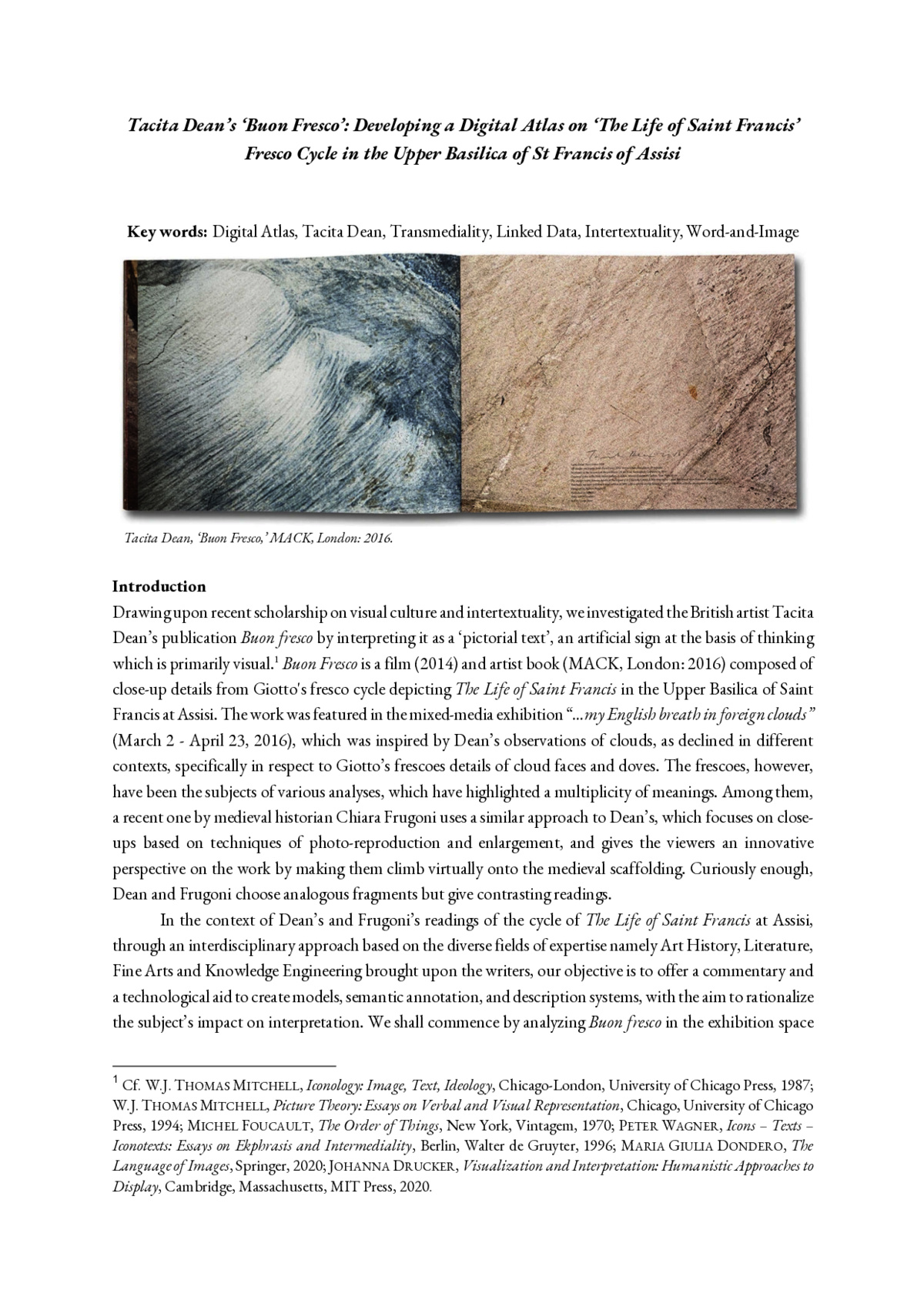 Tacita Dean’s Buon Fresco: Developing a Digital Atlas on The Life of Saint Francis Fresco Cycle in the Upper Basilica of Saint Francis of AssisiNicola Carboni, Angelica Federici, and Giuditta CirnigliaroLinguistica e letteratura, Jun 2021
Tacita Dean’s Buon Fresco: Developing a Digital Atlas on The Life of Saint Francis Fresco Cycle in the Upper Basilica of Saint Francis of AssisiNicola Carboni, Angelica Federici, and Giuditta CirnigliaroLinguistica e letteratura, Jun 2021This article aims to demonstrate how the layers of a complex image-text resource can be separated, examined, and presented to specialists and the general public alike, making evident the author’s intentions and purpose throughout the lenses of digital methodologies. Drawing upon recent scholarship on visual culture and intertextuality, we investigate Tacita Dean’s publication Buon fresco, an artist book (London, mack, 2016) drawn from the homonymous film (2014), which is composed of close-up details from Giotto’s fresco cycle depicting The Life of Saint Francis in the Upper Basilica of Saint Francis at Assisi. The frescos have been the subjects of various analyses, which have highlighted a multiplicity of meanings. Among them, a recent one by medieval historian Chiara Frugoni (2011, 2015) uses a similar approach to Dean’s, which focuses on close-ups based on techniques of photoreproduction and enlargement, and gives the viewers an innovative perspective on the work by making them virtually climb onto the medieval scaffolding. Curiously enough, Dean and Frugoni choose analogous fragments but give contrasting readings. The polysemic nature of the work is documented through the creation of a digital atlas that represents the diverse macro and micro readings of the text. The article explores how digital data can be used to illustrate a pictorial text, making evident the interconnections between the multitude of primary (denotation) and secondary (connotation) referents, and underlining how differences in cultural sensibility can result in the examination of various facets of a pictorial text as well as in divergent interpretations.
@article{carboniTacitaDeansBuon2021, title = {Tacita {{Dean}}'s {{Buon Fresco}}: Developing a Digital {{Atlas}} on {{The}} Life of {{Saint Francis Fresco}} Cycle in the Upper {{Basilica}} of {{Saint Francis}} of {{Assisi}}}, author = {Carboni, Nicola and Federici, Angelica and Cirnigliaro, Giuditta}, year = {2021}, journal = {Linguistica e letteratura}, volume = {XLVI}, number = {1/2}, pages = {73--107}, issn = {1724-0522}, doi = {10.19272/202101602004}, } -
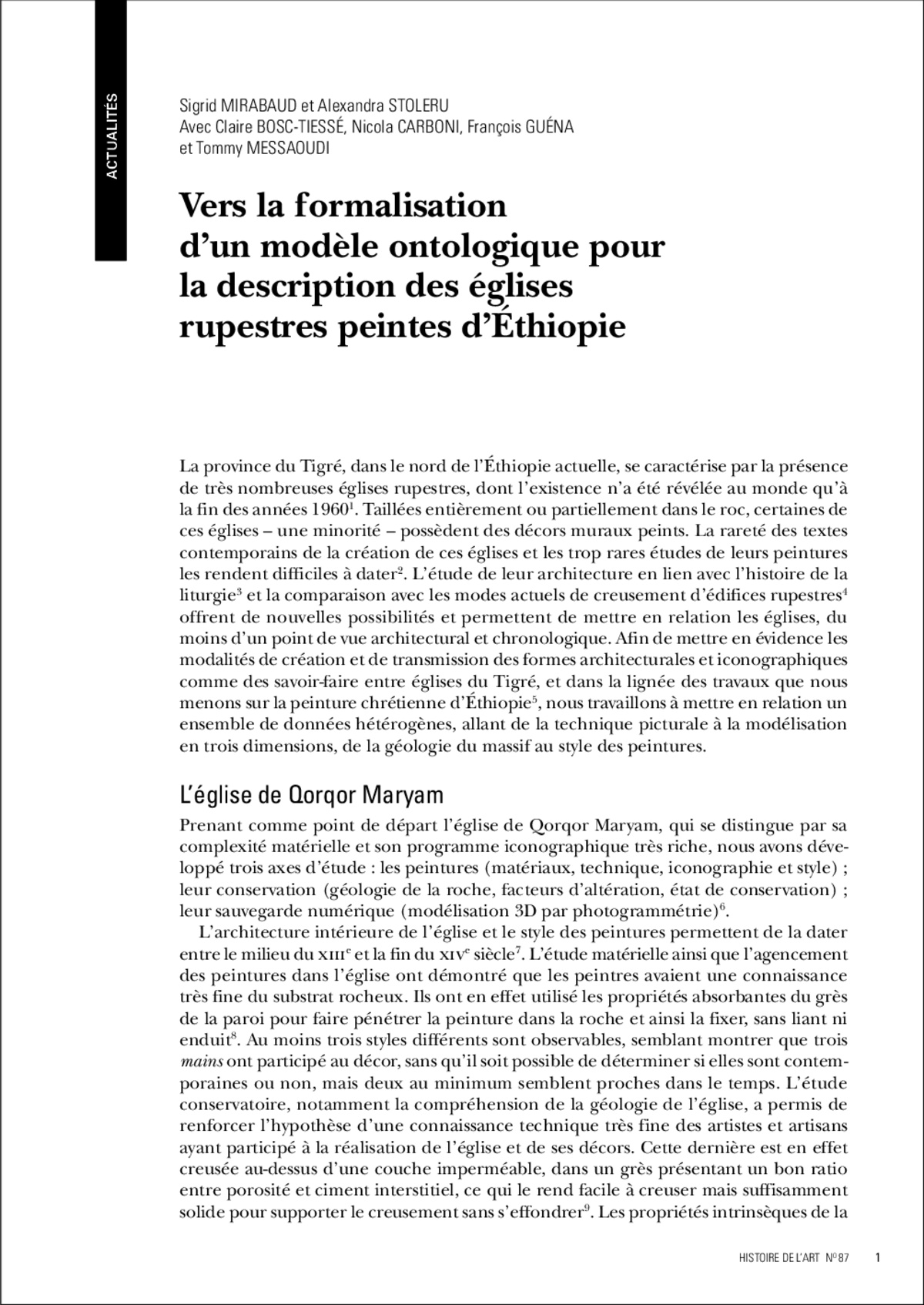 Vers La Formalisation d’un Modèle Ontologique Pour La Description Des Églises Rupestres Peintes d’ÉthiopieSigrid Mirabaud, Alexandra Stoleru, Claire Bosc-Tiessé, and 3 more authorsHistoire de l’art, Jun 2021
Vers La Formalisation d’un Modèle Ontologique Pour La Description Des Églises Rupestres Peintes d’ÉthiopieSigrid Mirabaud, Alexandra Stoleru, Claire Bosc-Tiessé, and 3 more authorsHistoire de l’art, Jun 2021@article{mirabaudVersFormalisationDun2021, title = {Vers La Formalisation d'un Mod{\`e}le Ontologique Pour La Description Des {\'E}glises Rupestres Peintes d'{{{\'E}thiopie}}}, author = {Mirabaud, Sigrid and Stoleru, Alexandra and {Bosc-Tiess{\'e}}, Claire and Carboni, Nicola and Gu{\'e}na, Fran{\c c}ois and Messaoudi, Tommy}, year = {2021}, journal = {Histoire de l'art}, number = {87}, }
2019
Journal Articles
-
 An Ontological Approach to the Description of Visual and Iconographical RepresentationsNicola Carboni and Livio de LucaHeritage, Jun 2019
An Ontological Approach to the Description of Visual and Iconographical RepresentationsNicola Carboni and Livio de LucaHeritage, Jun 2019The perception of our heritage is based on sign-functions, which relate visual representations to cognitive types, allowing us to make perceptual judgements over physical objects. The recording of these types of assertions is paramount for the comprehension and analysis of our heritage. The article investigates a theoretical framework for the organization of information related to visual works on the basis of the identity and symbolic value of their single constituent elements. The framework developed is then used as a driver for the grounding of a new ontology called VIR (Visual Representation), constructed as an extension of CIDOC-CRM (CIDOC Conceptual Reference Model). VIR sustains the recording of statements about the different structural units and relationships of a visual representation, differentiating between object and interpretative act. The result, tested with data describing Byzantine and Renaissance artworks, presents solutions for describing symbols and meanings of iconographical objects, providing new clustering methods in relation to their constitutive elements, subjects or interpretations.
@article{carboniOntologicalApproachDescription2019, title = {An {{Ontological Approach}} to the {{Description}} of {{Visual}} and {{Iconographical Representations}}}, author = {Carboni, Nicola and {de Luca}, Livio}, year = {2019}, journal = {Heritage}, volume = {2}, number = {2}, pages = {1191--1210}, doi = {10.3390/heritage2020078}, }
2017
Journal Articles
-
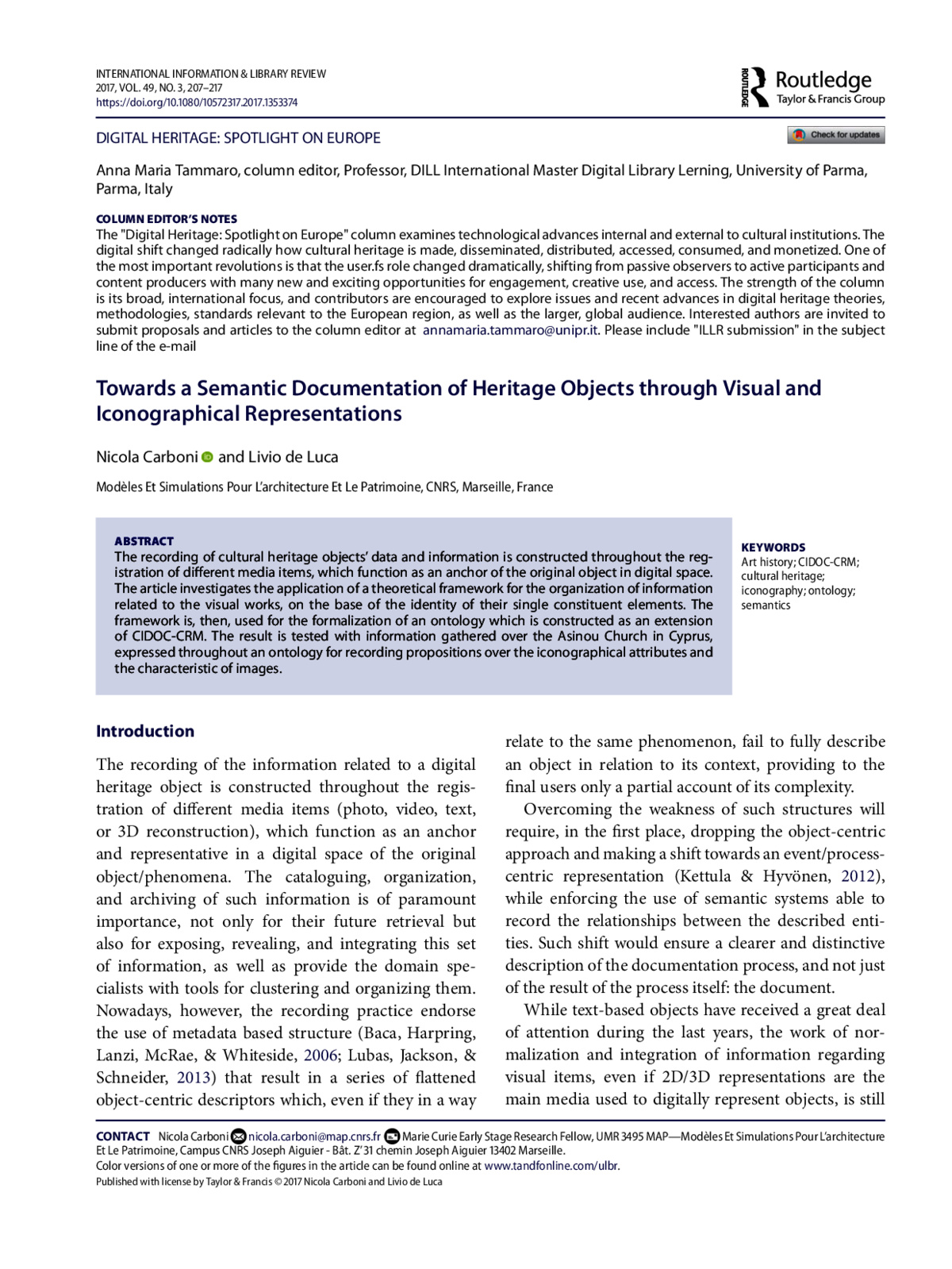 Towards a Semantic Documentation of Heritage Objects through Visual and Iconographical RepresentationsNicola Carboni and Livio De LucaInternational Information Library Review, Aug 2017
Towards a Semantic Documentation of Heritage Objects through Visual and Iconographical RepresentationsNicola Carboni and Livio De LucaInternational Information Library Review, Aug 2017The recording of cultural heritage objects’ data and information is constructed throughout the registration of different media items, which function as an anchor of the original object in digital space. The article investigates the application of a theoretical framework for the organization of information related to the visual works, on the base of the identity of their single constituent elements. The framework is, then, used for the formalization of an ontology which is constructed as an extension of CIDOC-CRM. The result is tested with information gathered over the Asinou Church in Cyprus, expressed throughout an ontology for recording propositions over the iconographical attributes and the characteristic of images.
@article{carboniSemanticDocumentationHeritage2017, title = {Towards a {{Semantic Documentation}} of {{Heritage Objects}} through {{Visual}} and {{Iconographical Representations}}}, author = {Carboni, Nicola and De Luca, Livio}, year = {2017}, month = aug, journal = {International Information Library Review}, volume = {49}, number = {3}, doi = {10.1080/10572317.2017.1353374}, } -
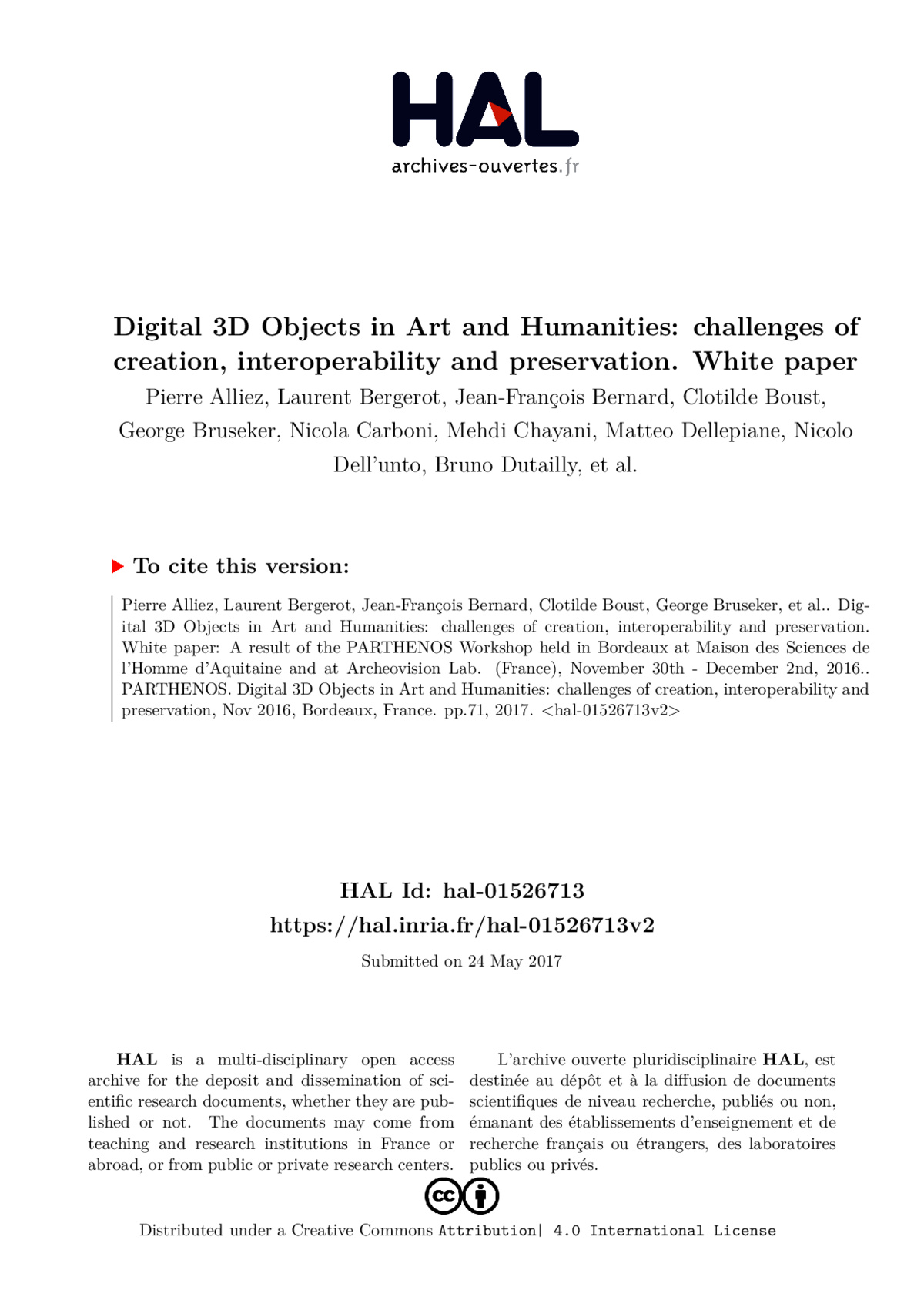 Digital 3D Objects in Art and Humanities: Challenges of Creation, Interoperability and Preservation. White PaperPierre Alliez, Laurent Bergerot, Jean-François Bernard, and 23 more authorsMay 2017
Digital 3D Objects in Art and Humanities: Challenges of Creation, Interoperability and Preservation. White PaperPierre Alliez, Laurent Bergerot, Jean-François Bernard, and 23 more authorsMay 2017With this White Paper, which gathers contributions from more than 25 experts of 3D imaging, modellng and processing, as well as professionals concerned with the interoperability and sustainability of research data, the PARTHENOS project aims at laying the foundations of a comprehensive environment centered on the researchers’ practices concerning 3D digital objects. The topics addressed in the document are meant to help to ensure the development of standardized good practices relating to the production, the handling, the long-term conservation and the reuse of 3D objects. Therefore, even if the focus is put on technical questions (formats, processing, and annotation), the White Paper also identifies the need to clarify the legal status of 3D objects, in order to facilitate their reuse(s) in non-research contexts, in particular in Museums.
@article{r01591, title = {Digital {{3D Objects}} in {{Art}} and {{Humanities}}: Challenges of Creation, Interoperability and Preservation. {{White}} Paper}, author = {Alliez, Pierre and Bergerot, Laurent and Bernard, Jean-Fran{\c c}ois and Boust, Clotilde and Bruseker, George and Carboni, Nicola and Chayani, Mehdi and Dellepiane, Matteo and Dell'unto, Nicolo and Dutailly, Bruno and Gautier, H{\'e}l{\`e}ne and Guidi, Gabriele and Guillem, Anais and Joffres, Adeline and Laroche, Florent and Manuel, Adeline and Manzetti, Maria Cristina and Michel, Alain and Pamart, Anthony and Ponce, Jean and Puren, Marie and Riondet, Charles and Echavarria, Karina Rodriguez and Romary, Laurent and Scopigno, Roberto and {Tournon-Valiente}, Sarah}, year = {2017}, month = may, pages = {71}, langid = {english}, }
Book Chapters
-
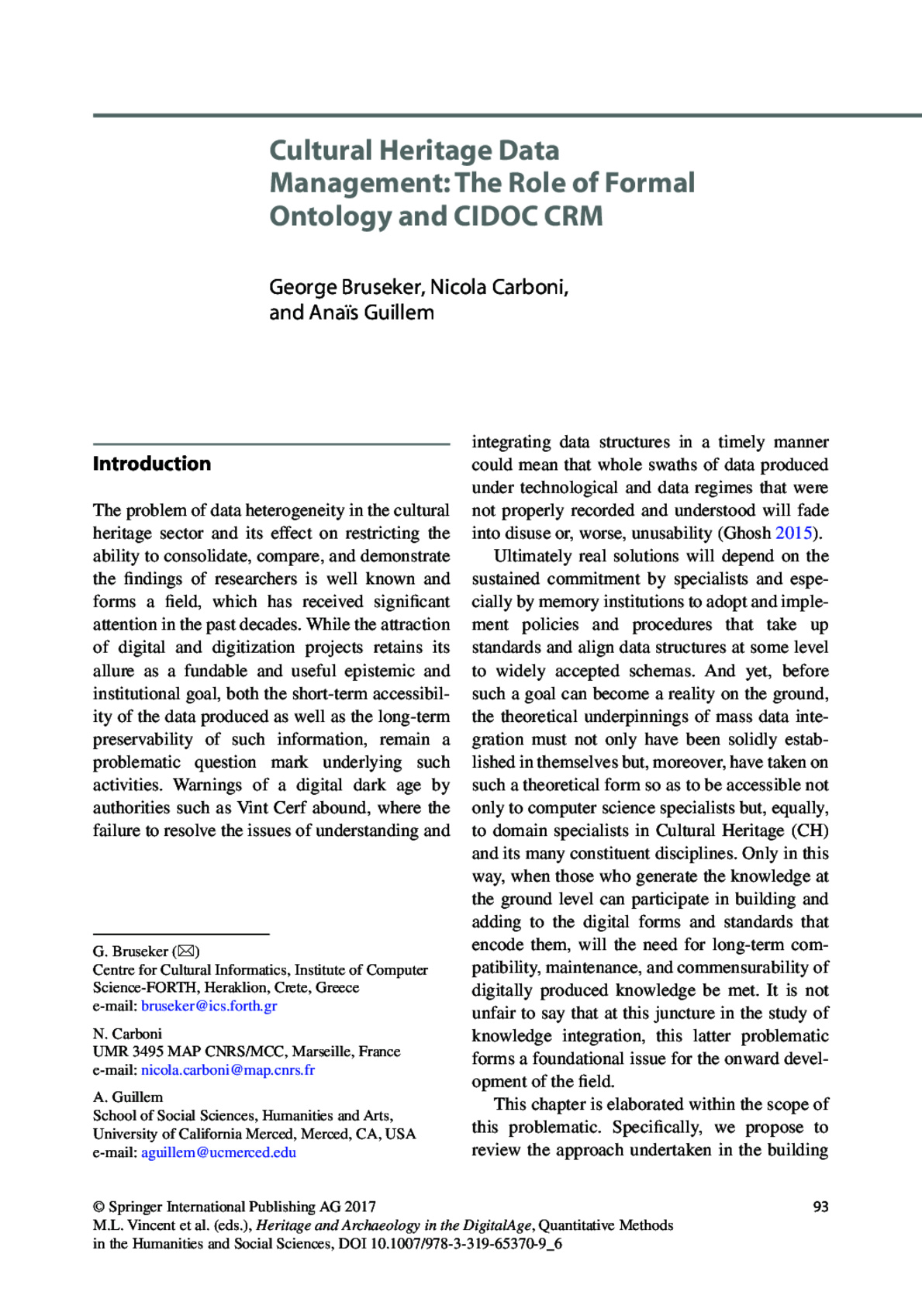 Cultural Heritage Data Management: The Role of Formal Ontology and CIDOC CRMGeorge Bruseker, Nicola Carboni, and Anais GuillemIn Heritage and Archaeology in the Digital Age, May 2017
Cultural Heritage Data Management: The Role of Formal Ontology and CIDOC CRMGeorge Bruseker, Nicola Carboni, and Anais GuillemIn Heritage and Archaeology in the Digital Age, May 2017Building models for integrating the diverse data generated in Cultural Heritage disciplines is a long-term challenge both for securing presently generated knowledge and for making it progressively more widely accessible and interoperable into the future. This chapter reviews the multiple approaches undertaken to address this problem, finally proposing CIDOC CRM as the most robust solution for information integration in CH. The chapter begins by outlining the data challenge specific to the field and the main approaches that can be taken in facing it. Within this frame, it distinguishes knowledge engineering and formal ontology from other information modelling techniques as the necessary approach for tackling the broader data integration problem. It then outlines the basic principles of CIDOC CRM, the ISO standard formal ontology for CH. From there, an overview is given of some of the work that has been done both theoretically and in practice over the past five years in developing and implementing CRM as a practical data integration strategy in CH, particularly looking at model extensions to handle knowledge provenance across various disciplines and typical documentation and reasoning activities, as well as at successful implementation projects. Lastly, it summarizes the present potentials and challenges for using CIDOC CRM for solving the CH data management and integration puzzle. The intended audience of this chapter are specialists from all backgrounds within the broader domain of CH with an interest in data integration and CIDOC CRM.
2016
Journal Articles
-
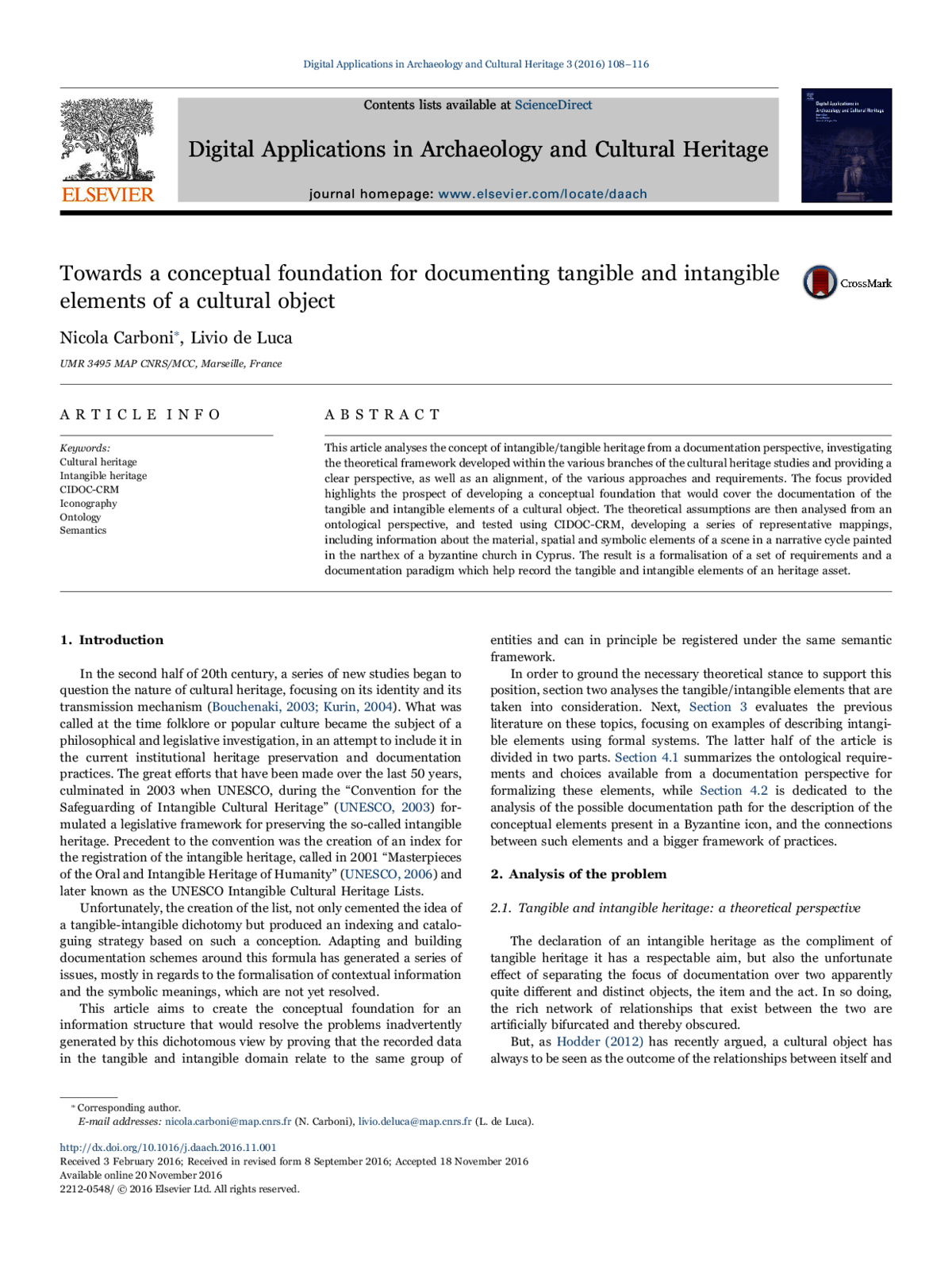 Towards a Conceptual Foundation for Documenting Tangible and Intangible Elements of a Cultural ObjectNicola Carboni and Livio De LucaDigital Applications in Archaeology and Cultural Heritage, May 2016
Towards a Conceptual Foundation for Documenting Tangible and Intangible Elements of a Cultural ObjectNicola Carboni and Livio De LucaDigital Applications in Archaeology and Cultural Heritage, May 2016This article analyses the concept of intangible/tangible heritage from a documentation perspective, investigating the theoretical framework developed within the various branches of the cultural heritage studies and providing a clear perspective, as well as an alignment, of the various approaches and requirements. The focus provided highlights the prospect of developing a conceptual foundation that would cover the documentation of the tangible and intangible elements of a cultural object. The theoretical assumptions are then analysed from an ontological perspective, and tested using CIDOC-CRM, developing a series of representative mappings, including information about the material, spatial and symbolic elements of a scene in a narrative cycle painted in the narthex of a byzantine church in Cyprus. The result is a formalisation of a set of requirements and a documentation paradigm which help record the tangible and intangible elements of an heritage asset.
@article{carboniConceptualFoundationDocumenting2016, title = {Towards a Conceptual Foundation for Documenting Tangible and Intangible Elements of a Cultural Object}, author = {Carboni, Nicola and De Luca, Livio}, year = {2016}, journal = {Digital Applications in Archaeology and Cultural Heritage}, volume = {3}, number = {4}, pages = {108--116}, doi = {10.1016/j.daach.2016.11.001}, } -
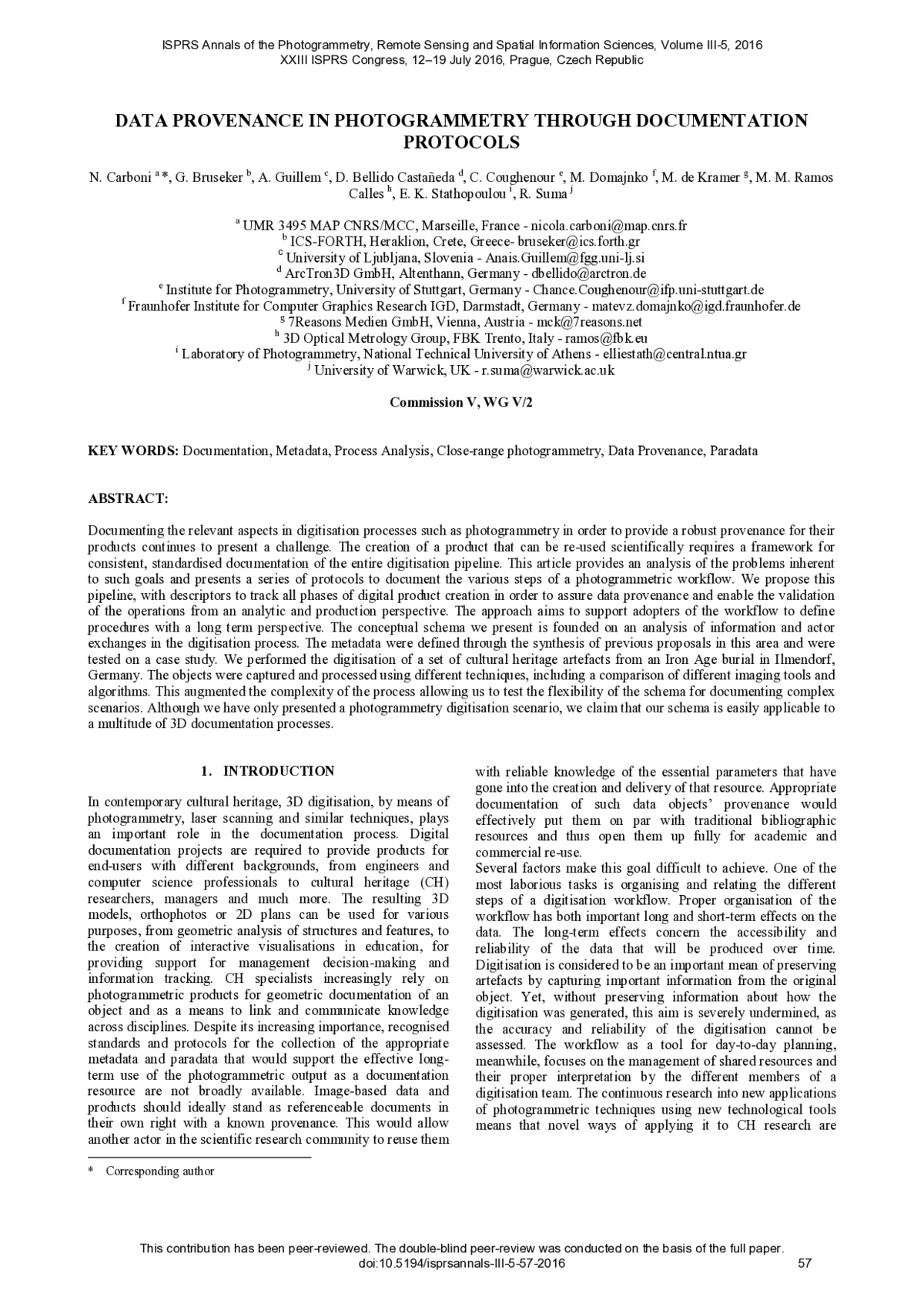 Data Provenance in Photogrammetry Through Documentation ProtocolsNicola Carboni, George Bruseker, Anais Guillem, and 7 more authorsISPRS Annals of Photogrammetry, Remote Sensing and Spatial Information Sciences, May 2016
Data Provenance in Photogrammetry Through Documentation ProtocolsNicola Carboni, George Bruseker, Anais Guillem, and 7 more authorsISPRS Annals of Photogrammetry, Remote Sensing and Spatial Information Sciences, May 2016Documenting the relevant aspects in digitisation processes such as photogrammetry in order to provide a robust provenance for their products continues to present a challenge. The creation of a product that can be re-used scientifically requires a framework for consistent, standardised documentation of the entire digitisation pipeline. This article provides an analysis of the problems inherent to such goals and presents a series of protocols to document the various steps of a photogrammetric workflow. We propose this pipeline, with descriptors to track all phases of digital product creation in order to assure data provenance and enable the validation of the operations from an analytic and production perspective. The approach aims to support adopters of the workflow to define procedures with a long term perspective. The conceptual schema we present is founded on an analysis of information and actor exchanges in the digitisation process. The metadata were defined through the synthesis of previous proposals in this area and were tested on a case study. We performed the digitisation of a set of cultural heritage artefacts from an Iron Age burial in Ilmendorf, Germany. The objects were captured and processed using different techniques, including a comparison of different imaging tools and algorithms. This augmented the complexity of the process allowing us to test the flexibility of the schema for documenting complex scenarios. Although we have only presented a photogrammetry digitisation scenario, we claim that our schema is easily applicable to a multitude of 3D documentation processes.
@article{carboniDataProvenancePhotogrammetry2016, title = {Data {{Provenance}} in {{Photogrammetry Through Documentation Protocols}}}, author = {Carboni, Nicola and Bruseker, George and Guillem, Anais and Bellido, Diego Casta{\~n}eda and Coughenour, Chance and Domajnko, M. and {de Kramer}, Marleen and Ramos, Magda Calles and Stathopoulou, Elisavet Konstantina and Suma, Rossella}, year = {2016}, journal = {ISPRS Annals of Photogrammetry, Remote Sensing and Spatial Information Sciences}, volume = {III}, number = {5}, pages = {1--8}, doi = {10.5194/isprsannals-III-5-57-2016}, }
Conference Articles
-
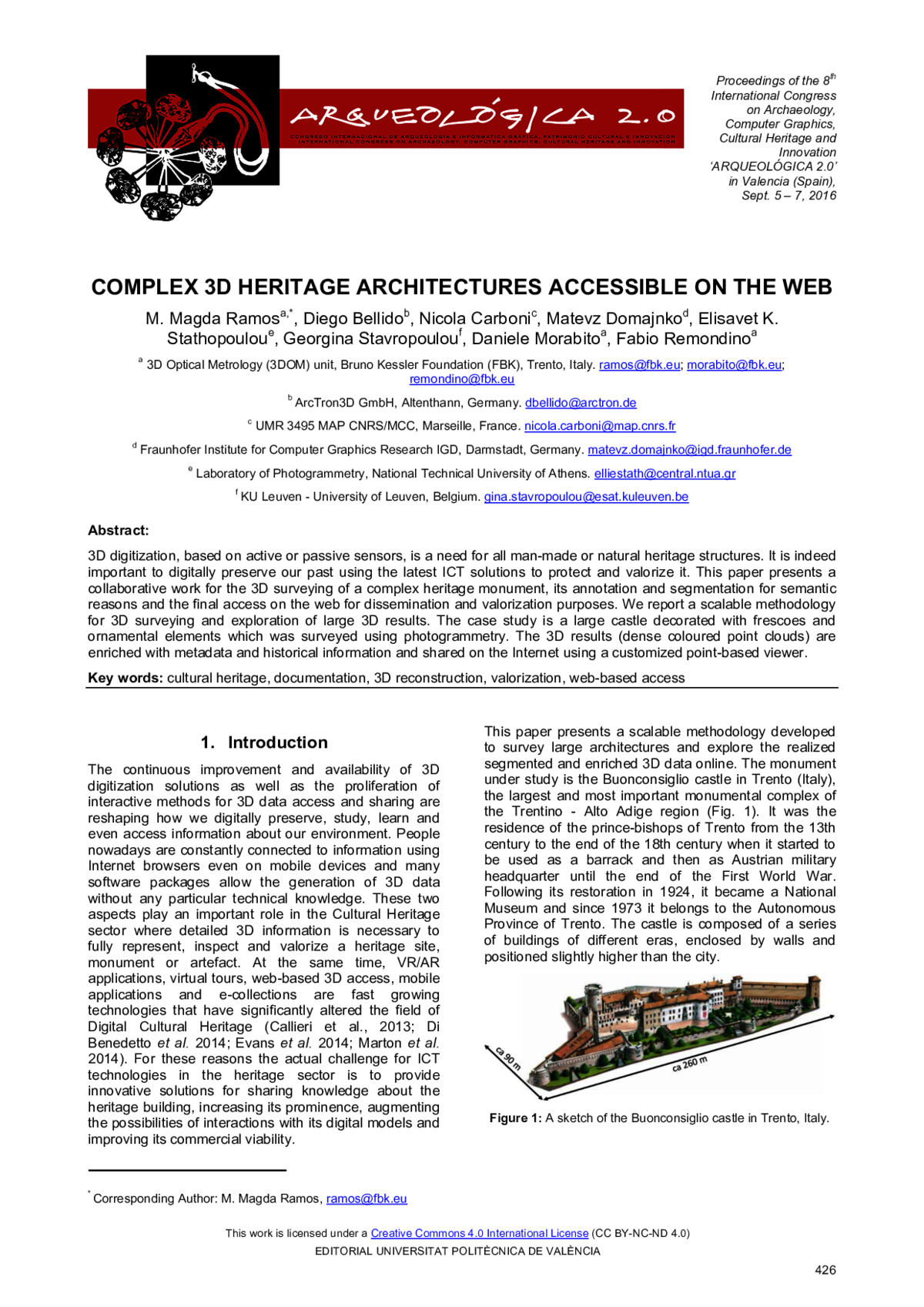 Complex 3D Heritage Architectures Accessible on the WebM. Magda Ramos Calles, Diego Bellido Castañeda, Nicola Carboni, and 5 more authorsIn 8th International Congress on Archaeology, Computer Graphics, Cultural Heritage and Innovation ‘ARQUEOLÓGICA 2.0’, May 2016
Complex 3D Heritage Architectures Accessible on the WebM. Magda Ramos Calles, Diego Bellido Castañeda, Nicola Carboni, and 5 more authorsIn 8th International Congress on Archaeology, Computer Graphics, Cultural Heritage and Innovation ‘ARQUEOLÓGICA 2.0’, May 20163D digitization, based on active or passive sensors, is a need for all man-made or natural heritage structures. It is indeed important to digitally preserve our past using the latest ICT solutions to protect and valorize it. This paper presents a collaborative work for the 3D surveying of a complex heritage monument, its annotation and segmentation for semantic reasons and the final access on the web for dissemination and valorization purposes. We report a scalable methodology for 3D surveying and exploration of large 3D results. The case study is a large castle decorated with frescoes and ornamental elements which was surveyed using photogrammetry. The 3D results (dense coloured point clouds) are enriched with metadata and historical information and shared on the Internet using a customized point-based viewer.
@inproceedings{m.magdaramoscallesComplex3DHeritage2016, title = {Complex {{3D Heritage Architectures Accessible}} on the {{Web}}}, booktitle = {8th {{International Congress}} on {{Archaeology}}, {{Computer Graphics}}, {{Cultural Heritage}} and {{Innovation}} `{{ARQUEOL{\'O}GICA}} 2.0'}, author = {Calles, M. Magda Ramos and Casta{\~n}eda, Diego Bellido and Carboni, Nicola and Domajnko, Matevz and Stathopoulou, Elisavet Konstantina and Stavropoulou, Georgina and Morabito, Daniele and Remondino, Fabio}, year = {2016}, volume = {Proceedings of the 8th International Congress on Archaeology, Computer Graphics, Cultural Heritage and Innovation `ARQUEOL{\'O}GICA 2.0'}, publisher = {Editorial Universitat Polit{\`e}cnica de Val{\`e}ncia}, doi = {10.4995/arqueologica8.2016.4479}, isbn = {978-84-9048-455-5}, }
2015
Journal Articles
-
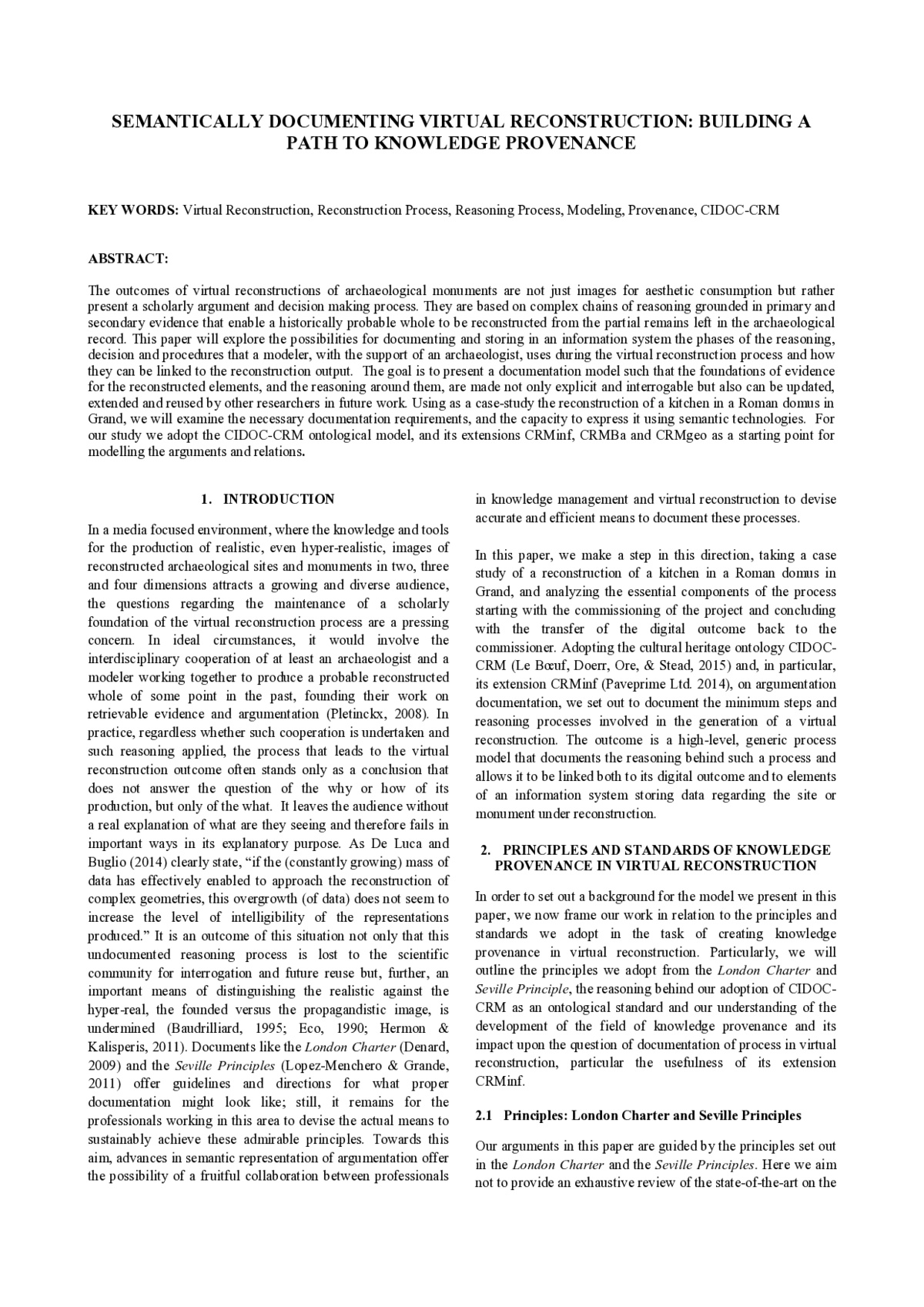 Semantically Documenting Virtual Reconstruction: Building a Path to Knowledge ProvenanceGeorge Bruseker, Anais Guillem, and Nicola CarboniISPRS Annals of Photogrammetry, Remote Sensing and Spatial Information Sciences, May 2015
Semantically Documenting Virtual Reconstruction: Building a Path to Knowledge ProvenanceGeorge Bruseker, Anais Guillem, and Nicola CarboniISPRS Annals of Photogrammetry, Remote Sensing and Spatial Information Sciences, May 2015The outcomes of virtual reconstructions of archaeological monuments are not just images for aesthetic consumption but rather present a scholarly argument and decision making process. They are based on complex chains of reasoning grounded in primary and secondary evidence that enable a historically probable whole to be reconstructed from the partial remains left in the archaeological record. This paper will explore the possibilities for documenting and storing in an information system the phases of the reasoning, decision and procedures that a modeler, with the support of an archaeologist, uses during the virtual reconstruction process and how they can be linked to the reconstruction output. The goal is to present a documentation model such that the foundations of evidence for the reconstructed elements, and the reasoning around them, are made not only explicit and interrogable but also can be updated, extended and reused by other researchers in future work. Using as a case-study the reconstruction of a kitchen in a Roman domus in Grand, we will examine the necessary documentation requirements, and the capacity to express it using semantic technologies. For our study we adopt the CIDOC-CRM ontological model, and its extensions CRMinf, CRMBa and CRMgeo as a starting point for modelling the arguments and relations.
@article{r01234, title = {Semantically {{Documenting Virtual Reconstruction}}: {{Building}} a {{Path}} to {{Knowledge Provenance}}}, author = {Bruseker, George and Guillem, Anais and Carboni, Nicola}, year = {2015}, journal = {ISPRS Annals of Photogrammetry, Remote Sensing and Spatial Information Sciences}, volume = {II-5/W3}, pages = {33--40}, doi = {10.5194/isprsannals-II-5-W3-33-2015}, langid = {english}, }